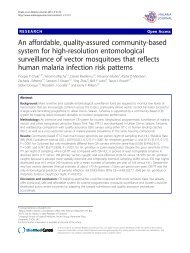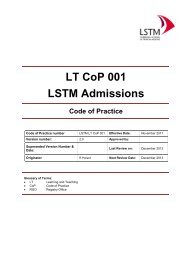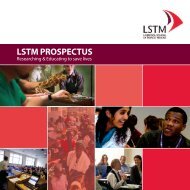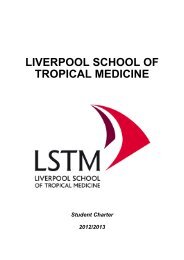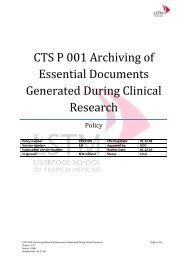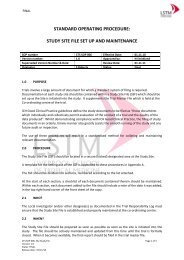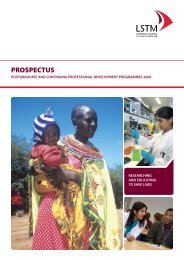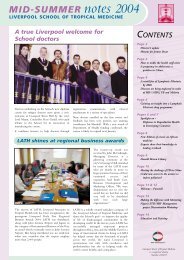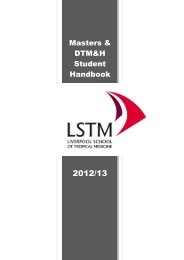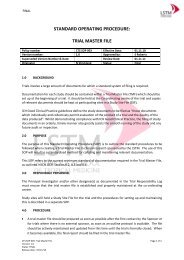Gender influences on child survival, health and nutrition: a ... - Unicef
Gender influences on child survival, health and nutrition: a ... - Unicef
Gender influences on child survival, health and nutrition: a ... - Unicef
Create successful ePaper yourself
Turn your PDF publications into a flip-book with our unique Google optimized e-Paper software.
<str<strong>on</strong>g>Gender</str<strong>on</strong>g> Influences On Child Survival, Health And Nutriti<strong>on</strong>: A Narrative Review<br />
different categories of household altogether. Male-headed households for example, inevitably include<br />
at least <strong>on</strong>e other female adult al<strong>on</strong>gside the male ‘head’ whereas female-headed households are<br />
defined by their absence of a male adult, whether temporary or permanent (Bruce & Lloyd 1997).<br />
Furthermore, when resp<strong>on</strong>ding to surveys <strong>on</strong> household headship, resp<strong>on</strong>dents might refer to older<br />
members within the household as heads, not because of their earning power, or even their decisi<strong>on</strong>making<br />
authority, but because of their seniority in age (ibid.). Bruce & Lloyd c<strong>on</strong>clude that regardless of<br />
household headship, the most significant aspect of intra household processes for analysis is whether<br />
or not men are financially c<strong>on</strong>tributing to their <strong>child</strong>ren, given that women wield less ec<strong>on</strong>omic power<br />
relative to men. The authors claim in fact, that regardless of men’s residential arrangements, “a<br />
n<strong>on</strong>c<strong>on</strong>tributing father in any household type is am<strong>on</strong>g the most severe welfare risks mothers <strong>and</strong><br />
<strong>child</strong>ren face” (Bruce & Lloyd, 1997, p. 222).<br />
Box 5: Women’s purchasing power versus decisi<strong>on</strong>-making power in the c<strong>on</strong>text of household<br />
headship<br />
Decisi<strong>on</strong>-making norms also affect preventive <strong>health</strong> practices in relati<strong>on</strong> to young <strong>child</strong>ren. For<br />
example an ethnographic study in Southern Tanzania, using interviewing <strong>and</strong> participant<br />
observati<strong>on</strong>, found that the acquisiti<strong>on</strong>, ownership <strong>and</strong> use of insecticide-treated bed-nets (ITNs),<br />
were closely linked to household headship. For female-headed households the most critical factor<br />
in acquiring a bed-net was whether they had the income to do so but for women who lived with<br />
their male partners the most significant factor was their ability to negotiate with the male heads<br />
of household. Interviews revealed that male heads were c<strong>on</strong>sidered resp<strong>on</strong>sible for decisi<strong>on</strong>s<br />
related to ITN purchase as well as whether or when <strong>child</strong>ren could use them despite increased<br />
female c<strong>on</strong>tributi<strong>on</strong>s to household livelihoods (Minja et al. 2001). While female-headed<br />
households lack the income to buy bed-nets <strong>and</strong> so may benefit from income-making<br />
opportunities, females in male-headed households lack authority to c<strong>on</strong>trol the use of bed-nets,<br />
even where they have c<strong>on</strong>tributed to the household purse through their own earnings. This<br />
dem<strong>on</strong>strates that women’s earning power does not always translate to decisi<strong>on</strong>-making power<br />
or access to household resources <strong>and</strong> should deter researchers from making assumpti<strong>on</strong>s in<br />
relati<strong>on</strong> to the drawbacks or benefits of specific types of household for young <strong>child</strong>ren.<br />
REVIEW OF STUDIES<br />
Women’s ability to access resources <strong>and</strong> allocate them successfully to their <strong>child</strong>ren is also affected by<br />
other aspects of intra-household dynamics, such as household structure <strong>and</strong> compositi<strong>on</strong>.<br />
Relati<strong>on</strong>ships between different members of the household differ across cultural c<strong>on</strong>text, especially<br />
when taking into account household headship <strong>and</strong> hierarchies of authority <strong>and</strong> seniority. In some<br />
c<strong>on</strong>texts household hierarchies may place a mother-in-law or gr<strong>and</strong>mother in a positi<strong>on</strong> of authority<br />
over a younger female.<br />
Researchers have dem<strong>on</strong>strated that greater authority over mothers by mothers-in-law has in some<br />
cases been associated with a detrimental effect <strong>on</strong> their gr<strong>and</strong><strong>child</strong>ren’s <strong>health</strong> <strong>and</strong> nutriti<strong>on</strong> (Castle<br />
1993; Doan & Bisharat 1990; Sim<strong>on</strong>, Adams & Madhavan 2002) 9 . However, in some c<strong>on</strong>texts, senior<br />
9 However this authority can also be beneficial in encouraging mothers to carry out good feeding practices. See<br />
secti<strong>on</strong> 1.4.2 for more discussi<strong>on</strong> <strong>on</strong> infant feeding <strong>and</strong> senior women.<br />
24



